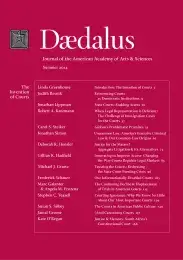(Anti)Canonizing Courts
Within U.S. constitutional culture, courts stand curiously apart from the society in which they sit. Among the many purposes this process of alienation serves is to “neutralize” the cognitive dissonance produced by Americans' current self-conception and the role our forebears' social and political culture played in producing historic injustice. The legal culture establishes such dissonance in part by structuring American constitutional argument around anticanonical cases: most especially “Dred Scott v. Sandford,” “Plessy v. Ferguson,” and “Lochner v. New York.” The widely held view that these decisions were “wrong the day they were decided” emphasizes the role of independent courts in producing them and diminishes the roles of culture in creating them and of social movements in overcoming them. This essay argues for approaching these decisions as ordinary products of political culture rather than extraordinary products of judicial malfeasance. Doing so honors those who struggled for progress and may invigorate our political imagination in the present.
Cadiz, Ohio isn’t “the proudest small town in America” for nothing.1 Cadiz has just 3,500 residents, but it has produced more than its share of American heroes. Edwin Stanton, the former U.S. Attorney General and Abraham Lincoln’s Secretary of War, lived and practiced law in Cadiz. The town was a one-time home to George Custer, who, prior to his infamy at Little Bighorn, helped secure Robert E. Lee’s surrender at Appomattox. And Cadiz was the hometown of John Bingham, the Republican senator, prosecutor of Lincoln’s assassins, and principal drafter of section one of the Fourteenth Amendment. If the Civil War and Reconstruction inaugurated America’s “second founding,”2 these sons of Cadiz were among its second founders.
The most popular tourist attraction in Cadiz honors none of these men: it is, rather, a museum of the reconstructed birthplace of Clark Gable. Gable is most famous, of course, for his portrayal of Rhett Butler, the charming, iconoclastic antihero of the film adaptation of Margaret Mitchell’s novel Gone with the Wind. It is ironic but not surprising that Cadiz is known and celebrated less for its famous Civil War . . .
